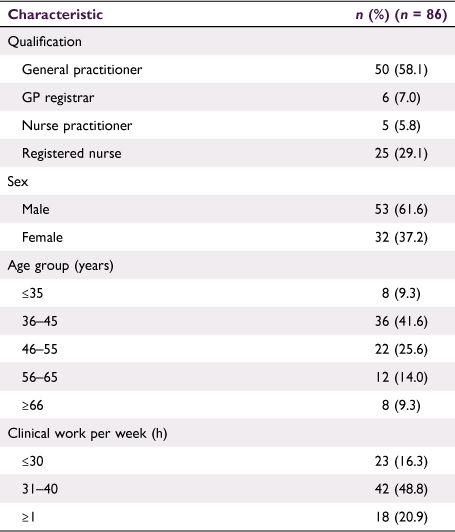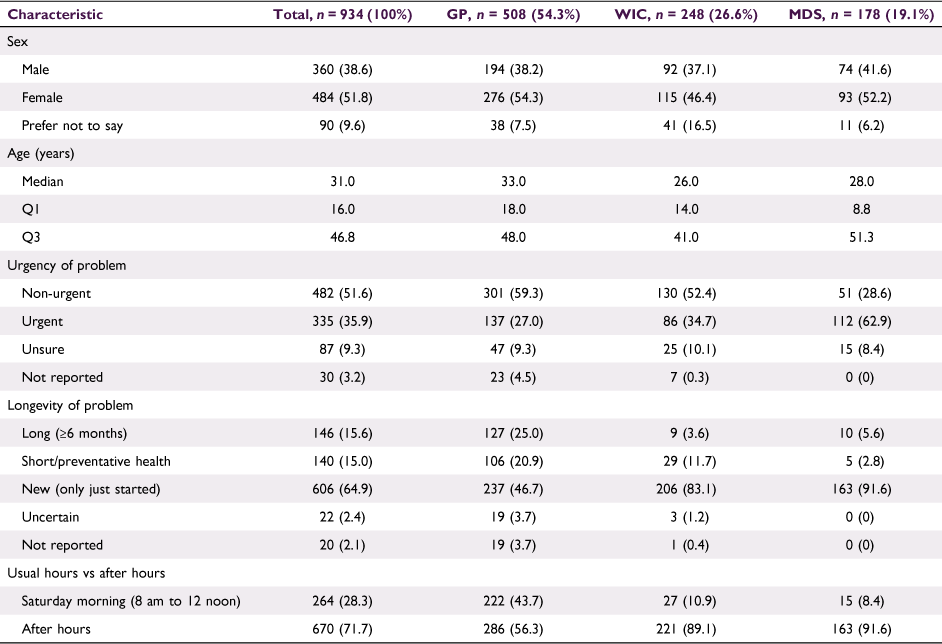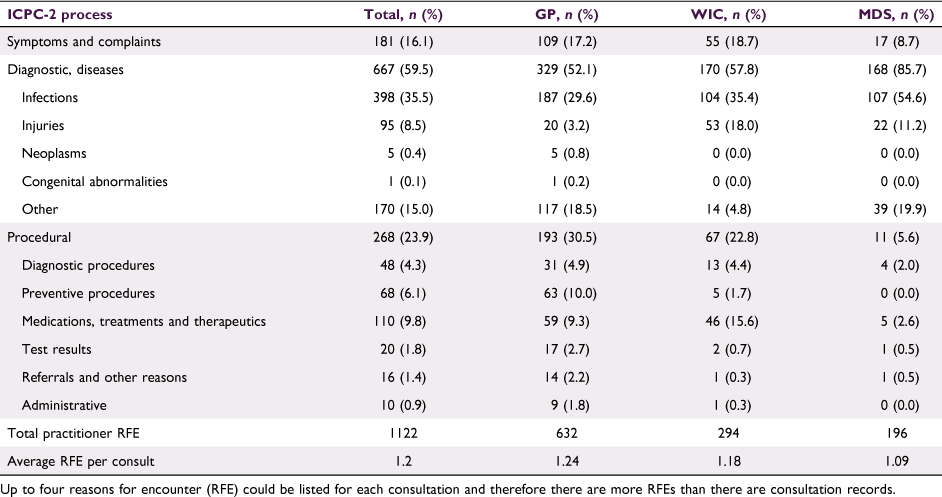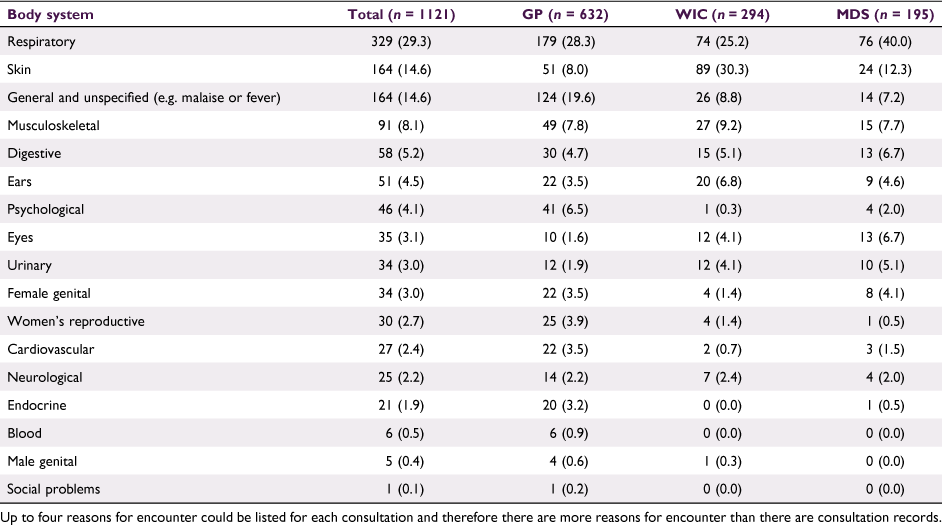After-hours presentations to community-based primary care in the Australian Capital Territory
Katelyn Barnes A B * , Jason Agostino B C , Dagmar Ceramidas A B and Kirsty Douglas A BA Academic Unit of General Practice, Office of Professional Leadership and Education, ACT Health Directorate, Canberra, ACT, Australia.
B Medical School, College of Health and Medicine, Australian National University, Canberra, ACT, Australia.
C Research School of Population Health, College of Health and Medicine, Australian National University, Canberra, ACT, Australia.
Australian Journal of Primary Health 28(3) 232-238 https://doi.org/10.1071/PY21261
Submitted: 10 November 2021 Accepted: 17 January 2022 Published: 17 March 2022
© 2022 The Author(s) (or their employer(s)). Published by CSIRO Publishing on behalf of La Trobe University. This is an open access article distributed under the Creative Commons Attribution-NonCommercial-NoDerivatives 4.0 International License (CC BY-NC-ND)
Abstract
Backgound: This study describes patient characteristics and presentations to community-based primary care medical services in the after-hours period.
Methods: A cross-sectional survey completed by practitioners was voluntarily conducted over one weeknight and weekend in 2019 at 31 of 51 extended hours general practices (GP), three of three medical deputising services and three of three nurse-led walk-in clinics (WICs).
Results: Of 3371 community-based after-hours presentations, 934 consultation records were obtained (overall response: 28%). Emergency departments reported 524 triage code 4 and 5 patients within the study period. Problems managed in community-based after-hours services were most often rated as non-urgent (n = 482; 51.6%) and new (n = 606; 64.9%). The most common community-based after-hours presentations were diagnostic or disease related (e.g. infections or injury; n = 667; 59.5%). The most common body systems impacted were respiratory (n = 329; 29.6%), skin (n = 164; 16.4%) and general/unspecified (e.g. fever; n = 164; 16.4%). Community-based after-hours services reported different types of presentations, with medical deputising services reporting more urgent presentations, GPs reporting more procedural presentations and walk-in clinics reporting more skin-related issues (e.g. wound care).
Conclusions: Community-based after-hours medical services contribute significantly to after-hours medical care in the ACT. Patients are self-selecting community-based after-hours medical services appropriately based on problems managed by practitioners.
Keywords: emergency medicine, health policy, health-seeking behaviour, health services research, health service utilisation, health systems, primary care.
Introduction
After-hours medical care is traditionally a hybrid model of care that includes emergency departments (EDs), extended hours’ general practices (GPs) and other community-based care, such as nurses. There are inefficiencies of hybrid models, with health service and policy concern around the number of potentially inappropriate ED presentations (Thompson et al. 2013; Jackson 2014; Health Policy Analysis 2020). In Australia, federal and state governments are interested in reducing ED wait times, and increasing reliance on community-based after-hours services (Jackson 2014; Australian Institute of Health and Welfare 2020; Health Policy Analysis 2020).
Common rhetoric in government reports and media is that ‘non-urgent’ presentations to ED are inappropriate, and could be better managed by community-based after-hours services (Australian Institute of Health and Welfare 2020; Health Policy Analysis 2020; Roy 2021). Non-urgent ED presentations in Australia are defined as Australian Triage Scale 4 and 5 (ATS 4&5). ATS 4&5 presentations contribute ~35% of all ED presentations, and 47% of ED presentations after hours (Australian Institute of Health and Welfare 2020). However, not all ATS 4&5 ED presentations are inappropriate, and the use of ATS 4&5 to classify inappropriate presentation is fraught with controversy (Duwalage et al. 2021). Furthermore, although international studies have shown fewer ‘non-urgent’ ED presentations with the introduction of after-hours community-based services, Australia already provides community-based after-hours services (Australian Government Department of Health 2021a, 2021b). The capacity of Australian community-based services to deliver timely care for ATS 4&5 presentations in addition to what is already being managed after hours is unclear.
Data on community-based primary care presentations after hours are limited. The Medicare Benefits Schedule shows urgent and non-urgent appointments, and timing of those claims; however, it cannot describe the presentation (Health Policy Analysis 2020; Australian Government Department of Health 2021a). A national study of GP presentations showed after-hours presentations often included fever, cuts and sore throat (Baker et al. 2020). However, the study only includes GPs and does not capture the traditional hybrid approach to after-hours medical care. Exploring presentations to all community-based after-hours services may help to inform appropriate after-hours models that support timely access to appropriate levels of care.
This paper describes and compares patient presentations across all community-based after-hours medical services in the ACT. In the ACT, after-hours community-based primary care medical services include extended hours GPs, nurse-led walk-in centres (WICs) and medical deputising services (MDS).
Methods
A cross-sectional survey of after-hours medical care was undertaken in May/June 2019 from 6 pm on Thursday to 8 am Monday; covering one weeknight and weekend. Data were not collected Friday 8 am to 6 pm. The MBS considers 8 am to 6 pm weekdays and 8 am to 12 noon Saturdays as usual hours for GPs (Australian Government Department of Health 2021a), although these are considered after hours for many other professions. As such, data collected Saturday morning were analysed separately to test for differences. This study was conducted in accordance with the Helsinki Declaration, and approved by the ACT Health Human Research Ethics Committee (2018/ETH00618) and Calvary Public Hospital Human Research Ethics Committee (Calvary ethics ID: 10-2019).
Participants, recruitment and consent
Potential sites included any medical service in the ACT, open after 6 pm Thursday or Friday for at least 2 h and anytime over the weekend. Potential sites included 50 GPs, three MDS locations, three WICs and two public EDs. The research team invited potential sites and individual practitioners to participate. ED managers excluded ED practitioners from participating due to the potential disruption to patient flow. However, each ED reported the total number of ATS 4&5 presentations during the study period. Patient participants included any person presenting to a participating site during the study, without obvious barriers to consent. Persons aged <18 years were included if a parent was able to consent and/or complete the survey. Patient participants were approached in the waiting room by a research assistant, provided study information and a consent card to give their treating practitioner to record non-specific consult information. Sites were offered a once-off payment for participation. Practitioners and patients were offered prize draw entries for one of 10 $100 vouchers.
Study tools
Practitioner participants completed a paper-based demographic questionnaire including questions on age, sex, location of practice, clinical hours worked per week and registration (General Practitioner, Medical Registrar, Practice Nurse or Registered Nurse). Practitioners also completed a paper consultation record for each consenting patient (see Supplementary material). The consultation record was informed by the BEACH survey (Britt et al. 2016) and took 2–3 min to complete per patient. The record included patient age and sex, a free-text list of up to four presenting problems, a free-text list of up to four problems managed, a range of management options employed (yes/no), perceived urgency of medical problems (urgent, non-urgent, uncertain) and perceived time to safely wait to be seen. Five GPs piloted the practitioner questionnaire and consult record to ensure face and content validity with no changes requested and time to complete the record being acceptable.
Data treatment and analysis
All paper records were entered into a purpose-developed database, and exported into SPSS v26 for analysis.
Date and time of presentation were used to group data into the Saturday morning period (Saturday 1 June 2019 8 am to 12 noon, defined by MBS as ‘usual hours’; Australian Government Department of Health 2021a), and all other times as after hours. Patient reasons for encounter and problems managed on the consult record were classified by one researcher using ICPC-2 (the International Classification of Primary Care; Classification Committee of the World Organization of Family Doctors 1998; Britt et al. 2016). A second researcher checked 30% of codes for accuracy. Rubric codes were used due to varied detail of responses. Where only patient reasons for encounter were listed, the same code was copied into ‘problem managed’ (Britt et al. 2016). Due to missing data and discrepancies on the consult record, this paper only reports problems managed.
Frequencies and percentages were used to describe the community-based practitioner participants, the patients they provided care to and general presentation information. Patient and general presentation descriptions are provided for the total population and by service type (GP, WIC, MDS). Patient age and sex were compared with ACT and Australian population descriptors for generalisability using Chi-squared goodness-of-fit (Australian Bureau of Statistics 2019). Comparisons of general presentation information were conducted by service type and time of presentation (Saturday morning vs after hours) using Pearson's Chi-squared test with Bonferroni corrections. Significance was conservatively set at P < 0.01.
Problems managed were described by the procedural code of the encounter (e.g. infection or administration), as well as body system affected (e.g. respiratory or skin). Problems managed were reported by total and by service type (GP, WIC and MDS). Frequencies and percentages described presentations overall. Comparisons by service type and by timing of presentation were completed using Pearson's Chi-squared test with Bonferroni corrections. Significance was conservatively set at P < 0.01.
Ethical approval
This study was conducted in accordance with the Helsinki Declaration, and approved by the ACT Health Human Research Ethics Committee (2019/LRE/00003) and Calvary Public Hospital Human Research Ethics Committee (CPHB HREC 10-2019). All participants provided appropriate informed consent.
Results
Sites included 31 GPs (62% of those GP open during the study period), three WICs (100%) and three MDS clinics (100%). A total of 934 consult records and 86 practitioner questionnaires were obtained. Included services reported a total of 3371 patients during the study period and 315 practitioners, providing a response rate of 28% for consult records and 27% for practitioner questionnaires. Two public EDs reported 524 patients with ATS 4&5 in the same period.
Practitioner characteristics
The majority of practitioners were GPs (58%), men (62%), aged >45 years (49%) and working full-time clinical hours (70%). Table 1 outlines the characteristics of practitioners who recorded information on consults.

|
Patient characteristics
Patient descriptors and general presentation information are displayed in Table 2 as totals and by service type.

|
The majority of patients were female (51.8%), with a median age (IQR) of 31 years (30.8 years). Compared with the ACT population, this sample has an underrepresentation of males (38.5% vs 49.4%; χ2 = 22.4; P < 0.01). Practitioners rated most presentations as new problems (n = 606; 64.9%) and non-urgent (n = 482; 51.6%). Just over one-quarter of patients presented on the Saturday morning (n = 264; 28.3%), and most Saturday morning presentations were to a GP (n = 222; 84.1%).
Most patients (n = 508; 54.3%) were seen in a GP, with a further 19.1% seen by locum GPs in MDS. One-quarter (n = 248; 26.6%) were seen by nurses in WICs. When comparing general presentation information by service type, practitioners from MDS reported a greater proportion of urgent presentations compared with GP and WIC (62.9% vs 27.0% and 62.9%; χ2 = 64.0; P < 0.001). Practitioners from GPs reported a greater proportion of long-term problems (25% vs 3.6% and 5.6%; χ2 = 73.96; P < 0.001) and short or preventive health problems (20.9% vs 11.7% and 2.8%; χ2 = 26.01; P < 0.001) compared with WIC and MDS. GP practitioners reported a lower proportion of new problems compared with WIC and MDS (46.7% vs 83.1% and 91.6%; χ2 = 161.29; P < 0.001). Significantly higher patient numbers were reported in GPs during the Saturday morning period compared with both WIC and MDS (43.7% vs 10.9% and 8.4%; χ2 = 130.87; P < 0.001), consistent with more GP practices being open during this time. As such, comparisons of presentations on Saturday morning with presentations after hours will be conducted within each service type, as opposed to comparing service types.
Within presentations to GP and MDS, general presentation descriptors did not differ on Saturday morning compared with after hours. Within WIC presentations, short-term and non-urgent problems were more frequently reported on a Saturday morning compared with after hours (44.4% vs 7.7%; χ2 = 31.25; P < 0.001; and 87.5% vs 50.2%; χ2 = 12.11; P < 0.001, respectively). Furthermore, within WIC presentations, new presentations more frequently reported after hours compared with Saturday morning (85.2% vs 59.4%; χ2 = 16.97; P < 0.001).
Types of presentations to after-hours primary care
A description of problems managed in community-based after-hours services by service type is displayed in Table 3 by ICPC-2 process code.

|
Community-based after-hours practitioners reported a total of 1122 problems managed over 934 consults, giving an average of 1.2 problems managed per consult. Most problems managed were diagnostic or disease related (n = 667; 59.7%), with the most common being infections (n = 398; 35.3%). Nearly one-quarter of all problems managed were classed as procedural (e.g. advice, education, or medication review; n = 268; 23.9%).
When comparing problems managed by service type, MDS reported a significantly higher proportion of infections compared with GP and WIC (54.6% vs 29.6% and 35.4%; χ2 = 38.44; P < 0.001). GPs reported a significantly higher proportion of preventive health procedures than WIC and MDS (10.0% vs 1.7% and 0.0%; χ2 = 38.44; P < 0.001). GPs reported a significantly lower proportion of injuries compared with WIC and MDS (3.2% vs 18.0% and 11.2%; χ2 = 51.84; P < 0.001). WIC reported a significantly higher proportion of injuries compared with GP and MDS (18.0% vs 11.2% and 3.2%; χ2 = 47.61; P < 0.001). WIC reported a significantly higher proportion of medications, treatments and therapeutics (mostly dressing changes for wound care) compared with GP and MDS (15.6% vs 9.3% and 2.6%; χ2 = 15.21; P = 0.006), and WIC reported a significantly lower proportion of ‘other’ diagnoses compared with GP and MDS (4.8% vs 18.5% and 19.9%; χ2 = 33.64; P < 0.001). No significant differences were noted (P > 0.01) when comparing Saturday morning presentations with after-hours presentations within each service type.
Table 4 displays presentations to after-hours services by body system affected, ordered from most to least common total presentations.

|
The three most common body system issues managed during the study period were respiratory (n = 329; 29.2%), skin (n = 164; 14.6%) and general or unspecified presentations (e.g. fever or malaise; n = 164; 14.6%). These three body systems account for >50% of all community-based after-hours presentations.
The most common problems managed for respiratory presentations were infections (n = 243/329; 74.4%). The most common problem managed for skin presentations were procedural (e.g. wound care; n = 48/164; 29.3%) or injuries (e.g. laceration; n = 41/164; 25.0%); and for general/unspecified issues was medications, treatments and therapeutics (e.g. medication review; n = 50/164; 30.5%) and preventive procedures (e.g. vaccinations; n = 29/164; 17.7%).
Compared with WIC and MDS, GP reported significantly higher proportions of general/unspecified issues (8.8% and 7.1% vs 19.6%; χ2 = 29.16; P < 0.001) and psychological issues (0.3% and 2.0% vs 6.5%; χ2 = 21.16; P < 0.001). Compared with GPs and MDSs, WIC reported significantly greater proportions of skin issues (8.0% and 12.2% vs 30.1%; χ2 = 77.44; P < 0.001). No significant differences were found between Saturday morning and after-hours presentations within each service type (P > 0.01).
Discussion
This paper explored patient presentations to community-based after-hours medical services to understand after-hours service use in the ACT. A large proportion of after-hours presentations were managed in community-based services, most frequently in GPs. Presentation characteristics varied by after hours service type, indicating the after-hours community-based primary care services meet different health needs.
GP dominated after-hours management, with the largest number of sites available and the greatest number of patients seen across the study period. GP has been acknowledged as the foundation for after-hours care (Jackson 2014), and in Australia, GPs are encouraged to remain open over the weekend (Australian Government Services Australia 2016; Australian Government Department of Health 2021b). Most GP practices in this study closed on Saturday afternoon and did not re-open until Monday morning. Although there was a proportional increase in presentations to WIC and MDS when GP availability decreased; there was not a statistically significant difference in the types of presentations to WIC and MDS between Saturday morning and after-hours periods. As such, it appears that after-hours GP is contributing significantly to after-hours care, and is managing specific types of presentations.
After-hours primary care presentations in the ACT were varied. The most common presentations were infection or injury, impacting the respiratory system or skin. These findings are aligned with previous research, which report fever and sore throat as the most common after-hours GP presentations (Baker et al. 2020). This study expanded previous understanding of community-based after-hours services by showing WIC managed a high proportion of skin-related issues and procedural consults (e.g. wound care), whereas MDS managed a high proportion of respiratory issues and infections (e.g. bronchitis). Respiratory presentations might have changed since COVID-19 and associated health service changes (telehealth, GP respiratory centres and COVID-19 testing centres; Desborough et al. 2020). Still, this study indicates that different types of community-based primary care services are providing care for different patient needs. Reproducing a similar study may help to show how the introduction of COVID-19-related services has changed after-hours medical care.
Presentations to each service appear to align with each services’ purpose. Extended-hours GPs managed a greater proportion of long-term and non-urgent problems, with a comparatively high proportion of procedural consultations in the after-hours periods. In contrast, MDS more frequently managed new and urgent problems; and WIC more frequently managed new and non-urgent problems. As such, it appears that GP provides ongoing patient care, MDS provides urgent once off GP care, and WICs serve more of a community nursing role. However, after-hours care is designated for urgent or semi-urgent care that cannot wait until usual hours (Australian Government Department of Health 2021a). As such, there appears to be incongruence between expected and actual presentations to after-hours services. Cost and sustainability of each service should be explored to best contextualise efficiency of services by use.
This study obtained a large sample size and good response rate to compare after-hours presentations across different types of primary care services in the ACT. Still, this study was underpowered to report specific presentations, and reverted to reporting broad categories captured by the ICPC-2 codes. Future studies should specify the level of detail required in open text responses, or use routinely collected practice data to code the types of presentations. The sample from this study may not be generalisable, as there was a significant underrepresentation of males compared with the ACT population (Australian Bureau of Statistics 2019). Furthermore, the ACT Health system may differ from other parts of Australia, as the ACT has fewer GPs per 100 000 population than most health districts, and WICs are relatively novel. Still, findings from this study may inform other health districts as to the potential roles of GPs, MDS and WICs, and may be used as comparative data.
Community-based primary care contributes significantly to the management of patients after hours. Different service types are used for different health needs; with urgent issues mostly managed by locum medical practitioners, non-urgent issues by WIC and ongoing or routine care issues by extended hours GP. Future research into patient choice and sustainability of services is required to better understand health service use in the after-hours period.
Data availability
The data that support this study cannot be publicly shared due to ethical or privacy reasons, although may be shared upon reasonable request to the corresponding author if appropriate.
Conflicts of interest
This study was funded by ACT Health, who also fund salaries for KB, DC and KD. The funder had no input into study design, data collection, analysis or interpretation. The authors declare no other conflicts of interest.
Declaration of funding
This study received funding from ACT Health as part of regular health service evaluation and planning.
Supplementary material
Supplementary material is available online.
Acknowledgements
This study would not have been possible without collaboration from multiple groups. The authors acknowledge and express deep gratitude for the contribution of: local GP clinicians in the design and interpretation of this study through the ACT Practice Based Research Network (PracNet); feedback on the survey design from Health Care Consumers Association (ACT); assistance from the Canberra Afterhours Locum Medical Service (CALMS) and Canberra Health Services in implementation of the study in their health services; dedication of all patients, clinicians and managers undertaking the study; and commitment of ANU Medical Student research assistants in collecting data.
References
Australian Bureau of Statistics (2019) Population by age and sex tables. Available at https://www.abs.gov.au/statistics/people/population/national-state-and-territory-population/dec-2019 [Accessed July 2021]Australian Government Department of Health (2021a) Medicare Benefits Schedule – Item 5020. Available at http://www9.health.gov.au/mbs/fullDisplay.cfm?type=item&qt=ItemID&q=5020 [Accessed July 2021]
Australian Government Department of Health (2021b) After hours primary health care. Available at https://www1.health.gov.au/internet/main/publishing.nsf/Content/primary-ahphc#:~:text=The%20PIP%20After%20Hours%20Incentive,to%20provide%20after%20hours%20access
Australian Government Services Australia (2016) After Hours Incentive Guidelines. Available at https://www.servicesaustralia.gov.au/organisations/health-professionals/services/medicare/practice-incentives-program/what-are-individual-incentives/after-hours-incentives
Australian Institute of Health and Welfare (2020) Use of emergency departments for lower urgency care: 2015–16 to 2018–19. Available at https://www.aihw.gov.au/reports/primary-health-care/use-of-ed-for-lower-urgency-care-2018-19/contents/lower-urgency-care/summary
Baker J, Britt H, Harrison C (2020) GP services in Australia: presentation profiles during usual practice hours and after-hours periods. Australian Journal of Primary Health 26, 117–123.
| GP services in Australia: presentation profiles during usual practice hours and after-hours periods.Crossref | GoogleScholarGoogle Scholar | 32307031PubMed |
Britt H, Miller GC, Bayram C, Henderson J, Valenti L, Harrison C, Pan Y, Charles J, Pollack AJ, Chambers T (2016) ‘A decade of Australian general practice activity 2006–07 to 2015–16.’ (Sydney University Press: Sydney, NSW, Australia)
Classification Committee of the World Organization of Family Doctors (1998) ‘ICPC-2: International Classification of Primary Care.’ 2nd edn. (Oxford University Press: Oxford, UK)
Desborough J, Hall Dykgraaf S, de Toca L, Davis S, Roberts L, Kelaher C, Kidd M (2020) Australia’s national COVID-19 primary care response. The Medical Journal of Australia 213, 104–106.
| Australia’s national COVID-19 primary care response.Crossref | GoogleScholarGoogle Scholar | 32623740PubMed |
Duwalage KI, Burkett E, White G, Wong A, Thompson MH (2021) Identifying and quantifying general practice‐type emergency department presentations. Emergency Medicine Australasia 33, 1049–1058.
| Identifying and quantifying general practice‐type emergency department presentations.Crossref | GoogleScholarGoogle Scholar | 34002478PubMed |
Health Policy Analysis (2020) Evaluation of PHN After Hours Program, Final report Volume 2 Main Report. Commonwealth Department of Health, Canberra, ACT, Australia.
Jackson, C (2014) Review of after hours primary health care: Report to the Minister for Health and Minister for Sport. (Canberra, ACT, Australia) Available at https://www1.health.gov.au/internet/main/publishing.nsf/Content/primary-ahphc-review
Roy T (2021) Canberra emergency department wait times are the worst in the country, but the Health Minister says she’ll fix it in nine months. ABC News 1 February 2021. Available at https://www.abc.net.au/news/2021-02-01/act-plans-to-reverse-emergency-wait-times-within-nine-months/13106742
Thompson MI, Lasserson D, McCann L, Thompson M, Heneghan C (2013) Suitability of emergency department attenders to be assessed in primary care: survey of general practitioner agreement in a random sample of triage records analysed in a service evaluation project. BMJ Open 3, e003612
| Suitability of emergency department attenders to be assessed in primary care: survey of general practitioner agreement in a random sample of triage records analysed in a service evaluation project.Crossref | GoogleScholarGoogle Scholar | 24319279PubMed |


